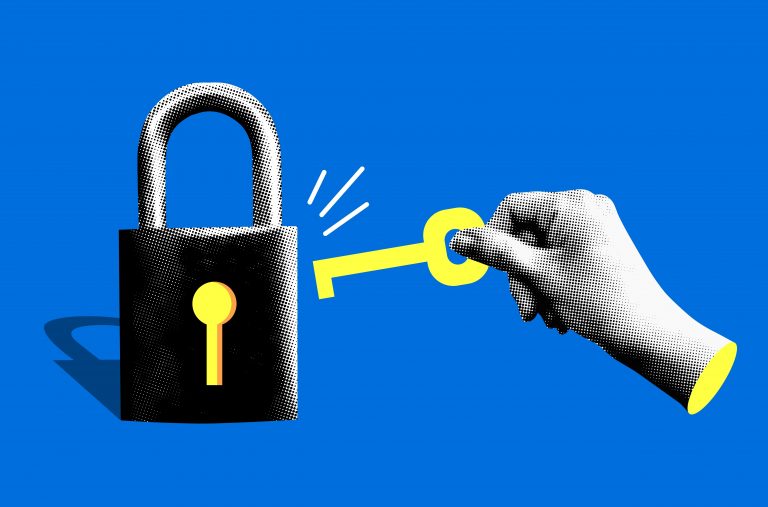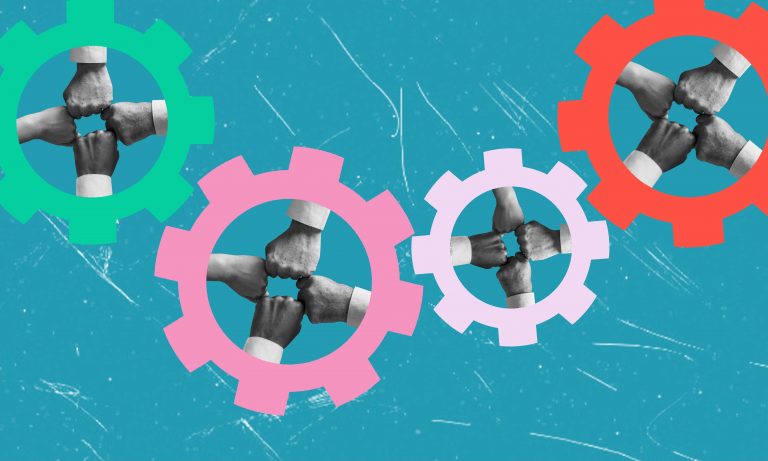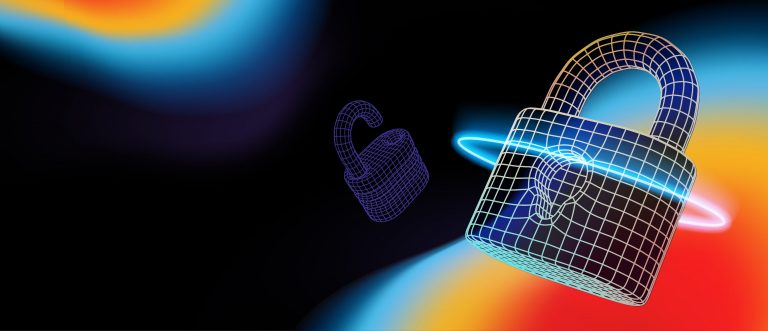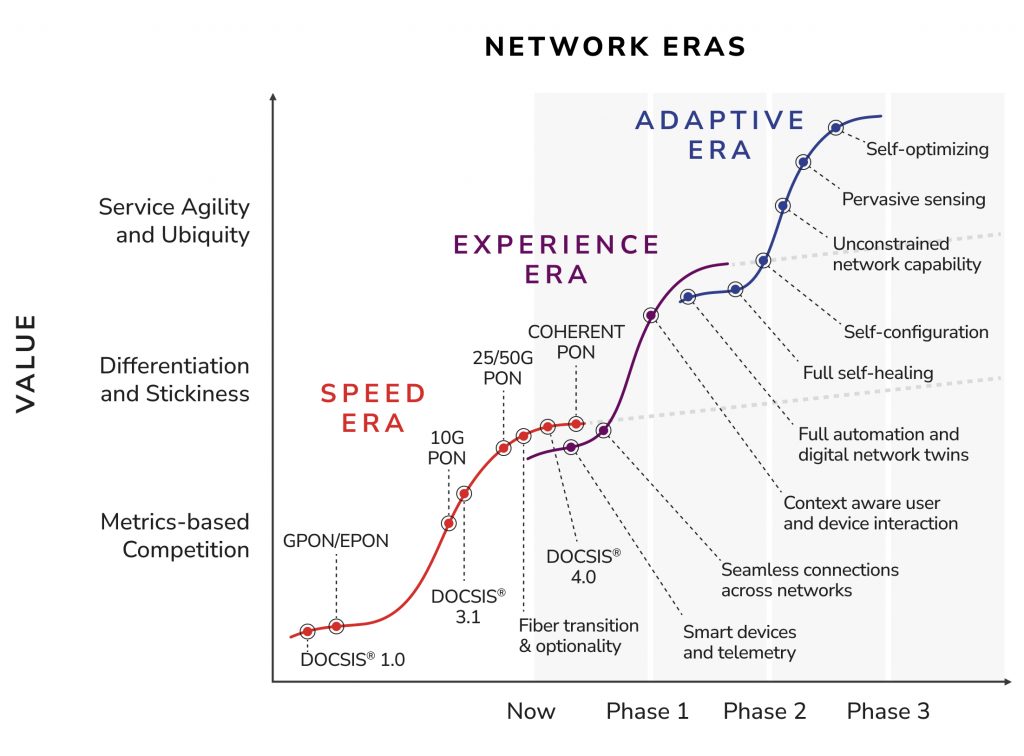Wired
Fiber: Laying the Groundwork for the Experience and Adaptive Eras

Key Points
- Fiber infrastructure supports the high-capacity and low-latency foundation needed to support seamless connectivity as user expectations evolve beyond raw speed.
- CableLabs’ work in fiber technologies — from FTTP to DPoE specifications — advances deployment efficiency and interoperability across the broadband ecosystem.
For years, the broadband industry’s innovative energy focused on speed: faster downloads, higher throughput, more gigabits per second. But as online activity has been woven more deeply into the fabric of daily life, user expectations have shifted. Today’s success metrics place less emphasis on speed and more on quality, reliability and seamless experiences that adapt to user needs.
CableLabs has been working on fiber optics throughout this evolution because we view fiber as a valuable, practical technology for broadband networks today — and one whose role and value continue to grow. The industry’s progression from the Speed Era to the Experience Era — and now toward the Adaptive Era — reinforces why fiber optics has been, and remains, foundational to the future of broadband.
Fiber as a Foundational Technology — Then and Now
This evolution from the Speed Era to the Experience Era, and ultimately toward the Adaptive Era, requires deliberate changes in how networks are designed, built and operated. Seamless connectivity and intelligent solutions demand high-capacity, reliable infrastructure that can support new technologies and service offerings.
Fiber optics is a key technology enabling this shift. Fiber optics enabled the Speed Era by addressing growing demands for throughput and scale. As the industry moved into the Experience Era, those same characteristics became essential for delivering consistent, high-quality connectivity — and fiber optics will continue to be a key enabler as networks evolve toward the Experience and Adaptive eras.
Fiber Optics at CableLabs
Fiber optics is widely recognized as the preferred broadband solution for new network builds among municipalities, utilities, telcos and traditional cable operators. Its ability to support significant capacity growth and evolving technologies makes it a strong foundation for future broadband innovation.
At CableLabs, our work in fiber optics spans the full lifecycle of fiber to the premises (FTTP) networks. This includes architecture, operations and management, interoperability, access technologies, provisioning and deployment efficiency — all focused on helping operators deploy and operate fiber networks at scale.
One example of CableLabs’ early work in fiber optics is the DOCSIS Provisioning of EPON (DPoE) specifications. Developed more than 15 years ago, DPoE enabled operators to use existing DOCSIS provisioning systems to configure and manage fiber-based customer premises equipment in much the same way they managed DOCSIS cable modems. This work helped reduce operational complexity, supported early FTTP deployments, and enabled the industry’s first 10 Gbps PON implementations — impacts that are still reflected in networks today, even as technologies continue to evolve.
Today, CableLabs’ fiber optics work continues across a wide range of specifications, research efforts and collaborative activities. This includes the Cable OpenOMCI specification and ongoing interoperability events that help ensure consistent, interoperable FTTP deployments across vendors and operators. CableLabs has also published reports on optical network operations and management and continues to work with vendor partners on specifying interoperable telemetry collection — supporting more observable, manageable and reliable optical networks.
CableLabs is also advancing the coherent PON specification, alongside research into PON security and the development of a complementary PON security specification designed to work in tandem with existing PON security mechanisms.
Beyond access networks, CableLabs’ advanced optics work includes coherent optics specifications, research into Distributed Fiber Optic Sensing (DFOS), advanced wavelength sources, wavelength switching technologies, hollow core fiber, and research into low-latency performance over optical networks.
Fiber Enabling the Experience and Adaptive Eras
Today’s users don’t want to think about their network connection. They simply want it to work — everywhere, on any device. Whether they are video-conferencing from home, streaming entertainment across multiple screens or relying on smart devices to manage daily life, the expectation is seamless performance without interruption.
Fiber optics delivers the speed, reliability and capacity necessary to power these experiences and keep pace with rising demands. More importantly, it provides the headroom required for experiences we cannot yet anticipate.
Looking ahead, the Adaptive Era envisions networks that sense, learn and respond to user needs in real time. These intelligent, context-aware networks will require infrastructure capable of supporting advanced capabilities such as AI-driven network optimization, real-time sensing and self-healing. Fiber optics provides the high-performance foundation these innovations require, enabling proactive maintenance, adaptive bandwidth allocation and self-optimizing networks.
For all-fiber deployments today, passive optical network (PON) technology remains a widely used and effective approach, offering the scalability, resiliency and reliability needed to support current services. At the same time, CableLabs continues to research and evaluate advanced optical technologies that could complement or succeed PON as network requirements and economic considerations evolve.
Fiber Optics as the Path Forward
Fiber optics is the strategic enabler that prepares the industry for whatever comes next. As a critical component of CableLabs’ Technology Vision and its Network Platform Evolution theme, fiber optics provides clear priorities for innovation, aligns with end-user expectations for performance and reliability, and offers a forward-looking foundation for long-term planning.
As broadband continues to evolve through new eras, applications, services and user expectations will inevitably change. Fiber optics provides the stable, high-capacity foundation that allows networks to adapt. CableLabs’ long-standing investment in fiber optics positions the industry to move forward with confidence — building scalable, interoperable and future-ready FTTP networks together.
Technology Vision
Shape the Future of Connectivity at CableLabs Tech Summit 2026

Key Points
- CableLabs Tech Summit is an exclusive networking and knowledge-sharing event for our member operators and exhibiting vendor community, building upon the successful format of its predecessor, CableLabs Winter Conference.
- Joanna Stern, author of the upcoming book “I AM NOT A ROBOT” and award-winning technology columnist at The Wall Street Journal, will deliver the keynote, exploring how consumer tech evolution is shaping broadband industry expectations.
- Registration is open now for the conference, scheduled for April 27–29, 2026, in Westminster, Colorado.
The broadband industry is evolving at unprecedented speed. As networks become more intelligent, adaptive and context-aware, collaboration is key to shaping what comes next. CableLabs Tech Summit 2026 is where that collaboration takes shape — connecting strategy with execution to accelerate innovation and scale what works.
Building on the legacy of CableLabs Winter Conference, the Tech Summit deepens the dialogue — uniting operators, exhibiting vendors and broadband leaders to focus on the industry’s most critical priorities. This private, practical forum is designed to move ideas into action.
Influence the Direction of the Industry — Together
With the Technology Vision as a shared foundation, Tech Summit fosters real-time collaboration through structured sessions, networking, working groups and an interactive exhibit floor. This year, the event will focus on how AI, automation and evolving service models are transforming the broadband experience, particularly across platform intelligence, DOCSIS technology and in-home reliability.
Much more than a traditional conference, CableLabs Tech Summit is a focused and comprehensive working session designed to strengthen relationships, spark collaboration and drive progress on shared priorities.
This intimate, closed-door event brings together CableLabs members and approved exhibitors to align on strategic priorities and turn insight into impact. Expect candid discussions, real-world use cases and collaborative problem-solving that drive innovation and strengthen industry momentum.
Featured Keynote: Joanna Stern of The Wall Street Journal
Joanna Stern, an Emmy Award-winning journalist and one of the most respected voices in personal technology today, will deliver the keynote. As a senior personal technology columnist for The Wall Street Journal, Joanna blends deep reporting with creativity, producing columns and videos that make complex topics accessible and entertaining.
Her upcoming book, “I AM NOT A ROBOT,” explores the impact of AI on daily life by chronicling a year in which she let artificial intelligence infiltrate nearly every aspect of her world. Throughout her career, Joanna has earned numerous honors, including Gerald Loeb Awards for her innovative journalism.
Smaller Market Conference
Ahead of Tech Summit on Monday, April 27, CableLabs invites small and mid-tier operators to join Smaller Market Conference, hosted by CableLabs and NCTA – The Internet & Television Association. Connect with and hear from executives and leaders from across the spectrum of responsibilities, representing business strategy, technology, engineering, marketing, operations and customer experience.
This event is available for CableLabs members and NCTA guests. Registration for Smaller Market Conference is separate from Tech Summit, so please register for both if you’re planning to attend.
Collaboration in Action at CableLabs Tech Summit 2026
Be part of the ecosystem defining the next generation of connectivity. Join us in Westminster, Colorado, April 27–29, 2026, for two days of strategic collaboration, practical insights and technology exploration — all built around CableLabs’ Technology Vision. Join us to:
- Explore and advance the industry’s Technology Vision: Delve into the technologies that define this strategic framework and collaborate with fellow members and vendors to advance the Technology Vision.
- Connect with fellow experts: Engage in meaningful discussions, share ideas and collaborate with leaders who are driving industry transformation.
- Future-proof your networks: Gain actionable insights to prepare your networks — and your teams — for the challenges and opportunities ahead.
Tech Summit kicks off on Monday, April 27, with a welcome reception followed by two full days of practical knowledge and enriching insights. This is an event you can’t afford to miss. Members who register by January 31, 2026, will receive an exclusive YETI tumbler.
Security
CableLabs Expands Engagement in the Connectivity Standards Alliance

Key Points
- CableLabs has advanced to Promoter Member status in the Connectivity Standards Alliance, gaining a board seat and greater influence over global Internet of Things and smart-home interoperability standards.
- As the broadband industry moves beyond speed as the primary differentiator, CableLabs is helping shape secure, reliable and interoperable device standards that improve the connected-home experience for consumers.
CableLabs has strengthened its role in the Connectivity Standards Alliance (CSA), becoming a Promoter Member and joining the Board of Directors. As smart homes become smarter and fill with more connected devices, the need for secure, reliable and interoperable devices has never been greater. Our expanded role enables us to help shape the standards that make that possible — from Matter to Zigbee to emerging Internet of Things (IoT) security frameworks.
The CSA is a standards development organization dedicated to the IoT industry and the connected home. It creates, manages and promotes several standards across several working groups including Matter, Zigbee, Product Security, Data Privacy and Aliro (physical access). CSA Matter devices use Wi-Fi and Thread to create an ecosystem “fabric” within the home to allow secure interoperability of IoT devices.
This work is increasingly critical as the broadband industry moves beyond speed as the primary differentiator. The foundation for CableLabs’ Technology Vision, our Eras of Broadband Innovation model illustrates the industry’s evolution from raw speed to intelligent, adaptive services.
These differentiating services are based upon a subscriber’s engagement with their networked devices — making it clear that continued increases in capacity, although necessary, will not be sufficient alone to meet the future connectivity expectations. Subscribers experience the network through their devices, and one of the first places they will see this is within the smart home and IoT space.
One of the heuristics in corporate governance is to use outsourced or contract IT help when operating fewer than 50-75 hosts, but to hire the first network admin once there are 75–100 managed hosts (or over 50 employees).
This year, Comcast reported that the average subscriber home has 36 connected devices. This means that managing those devices is likely already a concern for many consumers. How can operators make managing devices easier and safer for those subscribers? How can they ensure the complexity doesn’t lead to insecurity through user apathy or burdensome expectations?
Delivering the Best Experience Requires Collaboration
The Alliance’s objectives center on a simple premise: if subscribers enjoy their device interactions, if those devices work reliably and make life easier, if they’re secure and protect privacy, and if those devices are interoperable — the networks that make it all happen benefit. But the only way to make it work across manufacturers, ecosystems and technologies is for industry stakeholders to come together around a standards-based approach to secure device interoperability.
All of these customer experiences are areas where the broadband industry’s objectives intersect with those of smart home device providers and operators. Improving these experiences leads to increased adoption, which then drives cycles of economic growth for all participants in this sector — including those providing connectivity solutions.
Standardized, secure interoperability reduces network operator costs (e.g., support calls), lowers risk (e.g., insecure devices and botnets), enhances subscriber safety (e.g., home network vulnerabilities, physical premise security), simplifies device management (e.g., software updates) and improves the overall user experience. This is a key part of our engagement. The broadband industry’s role in providing a safe and easy subscriber experience doesn’t end at the cable modem.
CableLabs is engaging in this work for several reasons, which all play toward a larger vision:
- To help shape the future of smart home global IoT interoperability standards
- To represent the industry and interests in the global marketplace with subscribers
- To ensure broadband ecosystems have compatibility with devices using these standards
- To enhance the security posture of the broadband industry and within the smart home
- To promote industry collaboration and engagement including device manufacturers, ecosystem operators, testing labs, integrators, silicon providers and network operators
Taking On a Larger Leadership Role with CSA
CableLabs’ move from participant to promoter member will enable us to engage in organizational guiding decisions and take on additional leadership roles within the working groups. We’ll have increased visibility and opportunities across the organization, and we can keep the broadband industry front and center in each of these engagement areas.
The board representatives for CableLabs will be our CISO and Distinguished Technologist Brian Scriber and principal architect Jason Page.
We look forward to contributing our unique perspectives on the network operator ecosystem and our Technology Vision for the industry. We’ll also bring a deep understanding of connectivity tooling like Wi-Fi, the home gateway/router experience, security principles across communications protocols and production PKI operations related to consumer electronics security, as well as a thorough understanding of the policy and regulatory space related to cybersecurity and connected devices.
Wired
XGS-PON Interoperability Event Wraps Productive Year of Testing

Key Points
- The fourth XGS-PON Interop·Labs event of 2025 brought new suppliers and chipset families into the testing mix, deepening CableLabs’ supplier diversity.
- The event expanded test coverage to include new OMCI message exchanges and configuration scenarios, which were inspired by findings from earlier events.
- Test cases included new performance-monitoring tests, basic notifications tests and greatly enhanced test plan support for integrated PON gateways.
Our final Interop·Labs event of 2025 was held last month at CableLabs headquarters in Louisville, Colorado. As with prior events, the week focused on interoperability aspects of the ONU Management and Control Interface (OMCI), defined via a combination of ITU-T Recommendation G.988 and the CableLabs Cable OpenOMCI specification.
This event continued our approach of pairing optical line terminals (OLTs) and optical network units (ONUs) from different suppliers to exercise real-world configurations, management and monitoring behaviors. Supplier engineering teams arrived with updated software, new device variants and a fresh set of test cases built from lessons learned through the year’s earlier interop events.
Supplier Participation in the XGS-PON Interop
Participating suppliers of customer premises equipment (CPE) brought a wide range of XGS-PON ONUs and PON residential gateways, representing multiple chipset families. These devices were paired with OLT platforms from Calix (E7-2) and Nokia (Lightspan MF-2) in a collaborative lab environment designed to exercise aspects of the OMCI implementation of the ONUs.
The diversity of CPE devices — including those based on PON SoCs not previously tested at these events — created meaningful multi-vendor pairings. Several new ONU suppliers also joined this event, expanding the ecosystem represented in our lab.
For the November interop event, the following suppliers provided CPE devices: Calix (ONU and multiple gateways), Gemtek (gateway), Hitron (multiple ONUs), Nokia (multiple ONUs and gateway), Sagemcom (ONU and gateway), Sercomm (ONU), Ubee (ONU and gateway) and Vantiva (ONU).
Testing Environment and Themes
As with our August event, each OLT supplier had a dedicated workbench with a small-scale PON Optical Distribution Network. Engineers used OLT debugging tools and our XGS-PON analyzer to collect OMCI traces and performance data.
During the week of testing, engineers focused on several interoperability-related themes:
- The impact of the extended VLAN tagging — Downstream mode attribute on the handling of Priority Code Point (PCP)-marked frames
- OLT configuration to support vendor-specific gateway eRouter VLAN IDs
- MAC Bridge Service Profile (CPE MAC learning) behavior
- 64-bit Ethernet frame counter performance monitoring reporting
- Forwarding of jumbo Ethernet frames
- Notification and alarm behavior of ONU Ethernet link state changes
- Software download and activation processes
Across these themes, the goal of the event remained clear: identify inconsistencies, understand root causes and convert findings into actionable improvements. Test results were encouraging. Many items identified in earlier events have been addressed by suppliers, even as this expanded test coverage uncovered additional issues that will guide our next round of improvements.
This event capped a productive year of XGS-PON interoperability testing at CableLabs. Throughout 2025, we steadily grew supplier participation, evolved the test plan to cover critical OMCI features more thoroughly and expanded support for diverse device types — specifically integrated PON gateways.
In February, CableLabs brought together three OLT suppliers to test their DOCSIS Adaptation Layer implementations, demonstrating how operators can use familiar DOCSIS-style configuration files to provision services on XGS-PON networks. The event validated the viability of this provisioning approach for operators transitioning to ITU-T PON technologies without replacing existing back-office systems.
During our April event, we focused more deeply on the Cable OpenOMCI, marking a milestone in the industry’s effort to improve cross-vendor compatibility. OLT suppliers from Calix, Ciena and Nokia paired their systems with ONUs from six suppliers to test five core OMCI functions.
Then, in August, CableLabs hosted another OMCI-focused event, bringing together the largest group of OLT suppliers yet, alongside seven ONU suppliers. Engineers tested requirements from the I02 version of the Cable OpenOMCI specification, with expanded test cases covering ONU time synchronization and optical power levels.
Continuous Improvement Cycle
The I03 version of the Cable OpenOMCI specification — incorporating learnings from the April and August interop events — is available now. The findings from this event will be discussed in the CableLabs Common Provisioning and Management of PON (CPMP) working group and may generate new engineering change requests to the Cable OpenOMCI specification in the new year.
This cycle of lab testing, specification refinement and standards engagement is central to ensuring that XGS-PON networks can operate as truly multi-vendor systems.
See You Next Year
CableLabs has four additional PON Interop·Labs events scheduled in 2026, each focused on strengthening various aspects of ITU-T PON interoperability. We invite suppliers to join us in the CPMP and Optical Operations & Management working groups as we continue evolving our specifications. And we look forward to welcoming OLT and ONU suppliers back to our Louisville labs at our next interoperability event planned for January 2026.
Wired
The Pull of PNM: More Proactive, Less Maintenance Please

Key Points
- CableLabs and SCTE's proactive network maintenance working groups bring together operators and vendors to collaboratively develop tools and best practices that make network maintenance more proactive and efficient.
- These working groups offer opportunities for operators and vendors to shape the future of broadband network operations alongside other industry experts.
Proactive network maintenance (PNM) continues to make inroads on its goals of reducing troubleshooting time and cost while reducing the impact of network impairments on customer service. The broadband industry achieves this through grassroots efforts developed and shared by participants in two working groups. This global ecosystem of vendors and operators share their ideas, efforts and challenges to help move the community further on the path to efficient operations and improved services.
In a recent face-to-face meeting, we continued to make progress on several of the working groups’ workstreams, sprint toward some near term goals and set some long-term goals. And there is more to come!
Working Groups
CableLabs’ PNM Working Group (PNM WG) meets bi-weekly for all current work, with a focus on some specific workstreams on the off-weeks. SCTE's Network Operations Subcommittee Working Group 7 (NOS WG7) also focuses on proactive network maintenance and related workstreams. The CableLabs group focuses on developing the engineering and science to enable better PNM while NOS WG7 focuses on the field implementation of that engineering and science.
In addition, the chairs of these working groups meet often to manage the workstreams and ensure progress on key developments that benefit the industry most. Many members overlap between the two groups, which ensures an effective pipeline of research, development and implementation.
Workstreams
The proactive network maintenance working groups maintain progress on several developing workstreams, and a few of note have recently concluded.
Our Methodology for Intelligent Network Discovery (MIND) effort is an important workstream where we target repair efficiency through topology discovery and automation. Participants share developments and ideas on Thursdays, then bring the best results to Tuesday meetings, where we contribute canonical methods and software code for reference. This high cadence and open contribution are leading to well-developed ways to utilize channel estimation data for identifying features in the radio frequency (RF) network that aid in determining the ordinality and cardinality of network components. We accomplish this through an initial process of data cleanup to reveal the features in the signal, then through clustering and pattern matching methods we identify the features in the network and reveal the network's topology. As with all research, the initial process demonstrates functionality, which we have done; now we are working to make it reliable for all the diverse network designs and modify it for various PNM use cases.
The PNM WG has been working hard to develop GAI for Network Operations (NetOps) — or, more simply, AIOps. This group develops and shares the software and tooling to enable the output from NOS WG7 and PNM WG to be automated into network operations through retrieval-augmented generation (RAG) models and agentic AI solutions. In parallel, industry experts are peer reviewing the output from these GAI tools to ensure quality and engineering precision can be reliably delivered, improving on our own peer review process as we go.
Meanwhile, the PNM WG is developing standard ways to quantify impairments in the network as they are revealed in PNM data, referred to as the measurements work, to enable GAI applications and streamline PNM automation.
The PNM WG looks forward to publishing an update to our "Galactic Guide" at the beginning of 2026. The current version is available to the public. In the new version, you can look forward to receiving updates on the development of the measurements work and MIND work, in addition to initial methods to use Upstream Data Analysis (UDA), for those cable modems that can reveal the upstream spectrum.
New workstreams start when the groups complete earlier workstreams and queue up the next priority effort. The initial work on UDA was completed early this year, and more work on it is planned for the future. Likewise, NOS WG7 has recently completed outlining some new PNM training to come from SCTE, which updates the training to utilize new learning methods, and includes our newest knowledge about maintenance efficiency and proactivity.
PNM Face-to-Face
About once a year, CableLabs hosts a face-to-face meeting for these PNM groups and their members. We hosted a hybrid event in October with more than 30 participants representing many operators and vendors at our Colorado headquarters and through virtual attendance. Our time during the face-to-face focused on providing updates about our workstream progress, discussing potential future workstreams and developing content for the upcoming Galactic Guide update.
Near-Term Goals
The working groups are hyper-focused on a few key near-term results:
- Completion of the initial use case for channel estimation data to identify network features and determine the network topology. This is the MIND work.
- Unification on impairment quantification — and, specifically, the ability to monitor resiliency in DOCSIS® networks to transform PNM into managing capacity. Our measurements work will help operators better assess urgency with proactive repairs to prioritize work based on risk of customer impact.
- Identifying new UDA opportunities as new methods are published and further validated.
- Completing updates to the Galactic Guide, including incorporating new, more precise treatments of several important RF concepts published in our technical reports (such as several monographs published recently by SCTE’s NOS WG1).
Long-Term Goals
Accomplishments on our near-term goals open up new opportunities:
- The MIND work is not done; we still can develop better, automated localization for troubleshooting proactive and reactive network faults.
- One topic that will be important for our MIND goals is standardizing GIS information. This would allow the automation we created to work across tools and platforms for greater ease of use and broader adoption.
- We look forward to a forthcoming release of the new PNM training material from SCTE, which our expert participants intend to peer review further.
- As our work on GAI use for network operations continues, we intend to develop better input and better testing methods of these new tools to ensure their reliable application.
- The face-to-face meeting also revealed that we should make better use of our knowledge of noise, distortion and interference (NDI). By looking more closely and improving the categorization of these various signal impairments, we expect to identify their sources and locations through automation — which will help form additional efficient PNM opportunities.
Beyond Proactive Network Maintenance
While there is a substantial community working on RF and DOCSIS-related PNM, CableLabs doesn’t want to leave fiber out of the fun!
We are currently identifying near- and far-term opportunities in the passive optical networking (PON) world as well. As many operators push fiber deeper — all the way to the premises — the Optical Operations and Maintenance Working Group (OOM WG) works toward identifying use cases and aligning them to the telemetry that network elements provide. By better aligning PON and DOCSIS technologies, the group helps streamline network operations and maintenance further.
While the fun continues with DOCSIS technology and there is much more to develop, we are applying our experience with RF over coax to RF over fiber.
Whether your concerns are with maintaining DOCSIS or PON deployments, or ensuring network or service reliability, there is a community ready to work with you. Join a working group, and join the fun!
Wired
Unlocking Optical Fiber’s Potential: Distributed Sensing for Smarter Networks

Key Points
- Distributed fiber optic sensing turns standard optical fibers into thousands of sensors for real-time environmental awareness, infrastructure monitoring and intelligent network optimization — effectively creating an early-warning system that enables operators to prevent failures and improve network reliability.
- CableLabs invites operators, vendors and researchers to collaborate on field trials, standards development and commercialization strategies for this technology.
As cable networks evolve to meet the demands of next-generation connectivity, a quiet transformation is unfolding within the fibers that carry our data.
Distributed fiber optic sensing (DFOS) is emerging as a transformative technology that enables real-time environmental awareness, infrastructure monitoring and intelligent network optimization — all using the existing fiber infrastructure.
This sensing revolution reflects broader industry trends toward full automation, digital network twins and pervasive sensing in CableLabs’ Technology Vision, positioning cable networks as foundational platforms for intelligent and adaptive connectivity.
What Is Distributed Fiber Optic Sensing and Why Does It Matter?
DFOS turns standard optical fibers into thousands of sensors capable of detecting acoustic, thermal and mechanical disturbances. This capability allows operators to monitor their networks proactively, detect threats before they cause damage and even gather insights about the surrounding environment.
Two main approaches — backscatter-based and forward-based sensing — offer complementary strengths.
Backscatter systems, illustrated below in Figure 1, offer high spatial resolution and single-ended deployment, operating by transmitting laser pulses through the fiber and analyzing subtle variations in the reflected light. These changes carry unique signatures of acoustic, thermal or mechanical disturbances along the fiber.
The term “distributed” means that measurements are captured continuously along the entire length of the optical fiber (not just at discrete points), turning a single fiber strand into thousands of sensing locations.
Figure 1. Backscatter-based distributed sensing.
Forward-based DFOS, which Figure 2 shows, excels in long-distance sensing and seamless compatibility with existing optical amplifiers. By leveraging coherent transceivers already deployed in high-capacity networks, this approach enables operators to extract sensing information from the same signals used for data transmission, without requiring additional hardware.
This integration minimizes cost, simplifies deployment and opens the door to advanced analytics over hundreds of kilometers, making it ideal for large-scale infrastructure monitoring and proactive maintenance.
Figure 2. Forward-based distributed sensing.
Cable Networks as City-Wide Sensor Arrays
Imagine a city in which every fiber strand doubles as a sensor. With DFOS, this vision becomes reality. Cable operators can leverage their extensive fiber deployments to create ubiquitous sensing coverage. Bundled fiber paths traversing urban landscapes can detect vibrations, temperature changes and other anomalies — enabling smarter cities and safer infrastructure.
The “Network as Sensors” concept enabled by DFOS transforms optical fibers into thousands of sensing elements, enabling real-time monitoring of large-scale environments and infrastructure.
Real-World Impact: Field Trials and Use Cases
DFOS is already proving its value in the field for proactive maintenance, urban monitoring, environmental sensing and security applications.
Detecting early signs of fiber damage or accidental cable breaks is a key use of DFOS technology. It helps identify unusual activity near critical fiber links, allowing network operators to take preventive action before failures occur.
Researchers have demonstrated this capability using advanced transceivers on long-distance fiber links in real-world network environments. In one case, a DFOS system detected clear polarization changes several minutes before a buried cable was accidentally damaged during construction activity. Such early-warning signals, combined with advanced coherent transceivers, can improve network stability by enabling proactive rerouting and fault prevention.
DFOS is well-suited for cities, where existing fiber networks can be used to monitor traffic, construction and infrastructure conditions in real time. Its continuous, high-resolution sensing helps improve safety and resilience by spotting early signs of damage or stress in urban systems.
Recent studies in cities such as Hong Kong have shown that DFOS can identify and track vehicles based on their unique vibration patterns near roadside fibers. Combining acoustic vibration and temperature sensing has also proven effective for detecting underground issues, such as damaged or flooded cables, and showed strong potential for improving network reliability.
DFOS offers powerful capabilities for environmental and geophysical monitoring by transforming standard optical fibers into dense, real-time sensor arrays. It can detect and localize ground vibrations, temperature changes and strain along vast lengths of deployed fiber, making it ideal for monitoring earthquakes, landslides, permafrost thaw, subsea tsunamis and subsurface hydrological processes. DFOS allows researchers to observe dynamic environmental changes over time and across large areas. This enables early warning systems, long-term climate studies and enhanced understanding of natural hazards in both remote and populated regions.
DFOS can enhance security around critical infrastructure by complementing traditional tools like cameras, radar and lidar. Using vibration data along network fibers, it can detect and classify mechanical threats such as jackhammers or excavators. Researchers have shown that machine learning (ML) techniques, including transfer learning, can achieve high accuracy when analyzing these signals. This demonstrates that DFOS can reliably identify various types of mechanical activity, even when trained on limited or noisy data.
Overcoming Challenges and Looking Ahead
Although DFOS offers immense promise, several hurdles remain.
- Integrating sensing with live data traffic. The ultimate goal of fiber sensing is to use existing optical fiber networks to send data and sense environmental changes at the same time. However, DFOS systems still rely on unused “dark” fibers because combining sensing with live data traffic is difficult. Early tests showed that strong sensing pulses caused errors in nearby data channels. These high-power signals create interference through nonlinear effects, so the spacing between sensing and communication channels must be carefully controlled.
- Deploying in PONs. It’s challenging to integrate traditional DFOS techniques into access networks, such as passive optical networks (PONs), which employ passive power splitters to connect multiple homes and businesses to the internet. This is because the backscattered signals from various drop fibers of the splitters superimpose at the trunk fiber before being detected at the optical line terminal.
- Reducing interrogator costs. Most DFOS interrogators available today are costly because they’re designed for long-range operation, high optical power and specialized industrial applications such as oil and gas, security, and geophysical sensing. To enable broader deployment in communication networks, the technology must be scaled by reducing the per-unit cost and optimizing the design for operator-focused use cases.
- Training ML models on rare events. Training ML models to spot important events in DFOS data is key to realizing the full potential of fiber sensing, especially for rare but critical issues like early fiber damage or breaks. The challenge is that DFOS systems generate huge amounts of data, most of which come from harmless background noise. For instance, a system monitoring tens of kilometers of fiber can produce terabytes of data every day. As a result, meaningful events are buried in a sea of routine data, making it hard for ML models to learn what truly matters.
CableLabs is tackling these challenges with pioneering approaches:
- Coexistence strategies. A novel method enables sensing on active fiber networks without compromising broadband data channels. By using only a fraction of the fiber spectrum, operators can embed distributed sensors into live networks, eliminating the need for dedicated fiber strands and unlocking cost-effective scalability.
- Low-power coded sequences. CableLabs has demonstrated techniques that allow sensing signals to coexist seamlessly with traditional data channels, paving the way for integration without service disruption and enabling self-learning networks.
- Adaptive sensing algorithms. Leveraging AI and ML, these algorithms dynamically adjust to changing environments, improving detection accuracy and reducing false positives.
The cable industry now has a unique opportunity to lead in shaping sensing frameworks and driving global standards.
Join the Sensing Revolution
DFOS is more than a technical innovation; it’s a strategic asset for cable operators. By transforming fiber into a sensing platform, the industry can unlock new capabilities in resilience, intelligence and environmental awareness.
CableLabs invites operators, vendors and researchers to collaborate on field trials, standards development and commercialization strategies. Whether you're exploring sensing-as-a-service models or integrating AI-driven analytics, now is the time to engage. Reach out to us, Dr. Steve Jia and Dr. Karthik Choutagunta, to get started.
The future of cable isn’t just about faster speeds. It’s about smarter, more intelligent networks that anticipate, adapt and protect. CableLabs’ vision is to transform connectivity into a platform for innovation, where networks do more than transmit data: They sense, learn and respond in real time.
Network as a Service
Driving the Future of Network APIs: CableLabs’ Role in CAMARA’s Fall ’25 Meta-Release

Key Points
- Highlights from CAMARA’s fall 2025 meta-release delivered 60 standardized network APIs, moving the industry closer to delivering network functions that are as accessible as cloud services.
- Through its contributions to CAMARA, CableLabs is helping transform networks into programmable platforms that reduce integration complexity and accelerate innovation for members.
Open network APIs are changing the way innovation happens — turning networks into programmable platforms that applications can build on. The fall 2025 meta-release of CAMARA APIs represents a major milestone in open-source network innovation, and CableLabs is proud to be a key contributor.
From Quality on Demand to Simple Edge Discovery to the upcoming Session Insights and Network Access Management APIs, CableLabs continues to shape the foundation for the next generation of programmable networks.
CAMARA APIs in the Fall '25 Meta-Release
The CAMARA Project — supported by GSMA’s Open Gateway initiative — issued its latest meta-release on Oct. 7, 2025, marking another step toward API standardization and global interoperability. Read the press release to learn more.
Highlights include:
- 60 total APIs, including:
- 10 production-ready/stable APIs
- 27 updated since the spring ’25 release
- 23 brand-new initial APIs
- Expanded alignment with GSMA Open Gateway and TM Forum frameworks, helping developers “build once, deploy everywhere”
- New stable APIs such as Quality on Demand with Quality of Service (QoS) Profiles and Simple Edge Discovery
This CAMARA API release brings the network operator and developer communities closer to a world where network capabilities are as accessible as cloud services.
CableLabs’ Contributions to CAMARA APIs
Quality on Demand (QoD): Through our work on Quality on Demand, CableLabs helped further the efforts for application Quality of Experience for latency-sensitive use cases like AR/VR, gaming, telemedicine and industrial Internet of Things (IoT) — where predictable performance is essential.
Simple Edge Discovery: Route workloads to the nearest edge zone for improved response time and lower latency with Simple Edge Discovery.
Connectivity Insights: CableLabs contributed directly to Connectivity Insights, enabling application developers to get insights into the network connection quality.
Session Insights: While not part of the official meta-release, CableLabs’ Session Insights API has been published to CAMARA’s GitHub and will be available soon in an alpha release. It allows an application to provide real-time session-level analytics and telemetry to the network operator, giving applications real-time feedback on performance and network behavior — an important step toward data-driven service optimization.
Network Access Management: Similarly, Network Access Management is working to provide standardized methods to manage network access for both devices and users. It’s another foundational piece in making networks more programmable, secure and interoperable.
Why This Matters for CableLabs Members
Reducing Integration Complexity: By contributing to CAMARA’s open-source community, CableLabs helps member operators access solutions that scale across the broader connectivity ecosystem. This standardization of APIs reduces integration complexity and eliminates one-off builds, cutting both development time and cost.
Accelerating innovation: With open network APIs, members can prototype and deploy new services faster.
Ensuring global interoperability: CAMARA’s collaboration with GSMA Open Gateway ensures that implementations work across operators and borders.
Enhancing user experiences: Applications can now leverage network context to deliver smarter, more responsive and reliable services.
Differentiated Services: Members can leverage these APIs to create unique context-aware services through API-driven, interoperable architectures that enable seamless user experiences and introduce new revenue opportunities for operators.
Looking Ahead
CableLabs will continue advancing open API standards through our work in CAMARA and related initiatives. Upcoming milestones include:
- Preparing Session Insights and Network Access Management for alpha releases.
- Engaging with member operators and vendors to pilot CAMARA APIs in real-world environments.
- Contributing to future meta-releases that expand network capabilities for developers globally.
Join the Conversation
If you’re a CableLabs member or ecosystem partner, now is the time to explore these new APIs and their potential in your networks and services.
Read more about the CAMARA open-source project on its website and join the project on GitHub. If you are a CableLabs member or part of our vendor community, you can join the Network as a Service working group. Member operators can also learn more by visiting our Member Portal, which requires a CableLabs account to log in. Employees of member companies can register for an account here.
Together, we’re building the foundation for the next generation of programmable networks.
Security
A Unified Approach to AI Security in the Broadband Industry

Key Points
- AI has the potential to transform networks to be smarter, more adaptable and more reliable; however, this rapid evolution introduces new and complex security challenges.
- CableLabs is launching the AI Security Working Group to bring well-understood security principles into AI R&D, promoting best practices and practical security guidance for AI development to secure the cable broadband industry’s critical infrastructure.
AI is turning the vision of pervasively intelligent networks into reality. It’s becoming the driving force behind networks that are smarter, more adaptable, more reliable and more secure than ever. No longer limited to generating text, AI is evolving into an active operational agent within cable networks. It’s an evolution that unlocks unprecedented opportunities for innovation and new subscriber experiences.
However, this transformation also introduces new and complex security challenges.
Managing the Challenges of AI
Many of AI’s challenges stem from the relentless pace of innovation. New protocols, tools and methods are adopted soon after they emerge, leaving security as an afterthought. For instance, some AI agents are capable of autonomously interacting with data, using tools and calling APIs. All of this adds new layers of complexity, dependencies and attack surfaces. These risks should be carefully managed and addressed as early as possible in the design and development stages.
A key element in any risk management framework is grounding this innovation in a secure foundation that spans the entire AI stack, from the large language models (LLMs) at the core, to the AI agents and their prompts, to the tools and APIs they use, and finally to the AI protocols that connect and coordinate them.
CableLabs is investigating cable-specific elements where we can bring well-understood security principles into AI R&D, laying the foundation of protecting cable’s critical infrastructure from tampering and subversion. Just like any other software, the AI stack would benefit from provenance guarantees, integrity, identity assertions and transitive credentialing.
The AI Security Working Group
Because AI architectures interact directly with critical systems and sensitive data, securing the entire ecosystem — from clients and servers to the protocols that link them — isn’t just a technical best practice; it’s a strategic imperative for the industry. A unified focus on AI security will enable trusted communications and accelerate innovation across both business and technical domains.
To foster collaborative input and discussion, CableLabs is launching the AI Security Working Group (AISWG), a CableLabs member initiative focused on developing and promoting best common practices and practical security guidance for AI deployment relevant to the cable broadband industry. By bringing our members together in this forum, we can help our industry harness the transformative power of AI confidently, responsibly and securely.
CableLabs is also actively engaged in two other non-cable groups working on securing AI:
- The Messaging Malware Mobile Anti-Abuse Working Group (M3AAWG) is working on preventing abuse of and abuse from AI systems.
- The Open Worldwide Application Security Project (OWASP) is working on a broad range of threats to AI.
How You Can Help
There are a few ways CableLabs members can be part of this essential initiative:
- Maximize your membership: Register for a CableLabs account to explore exclusive, member-only resources and content.
- Join the working group: Request to join the AI Security Working Group, and help us define the future of AI security. (A CableLabs account is required to log in.)
- Connect with us: Introduce us to the people in your organization who are focused on AI security, governance and agent protocol implementation.
Wired
Thinking Outside the Box: Serving MTUs With Fiber

Key Points
- CableLabs’ FTTP Operators Forum brings together industry experts to tackle fiber deployment challenges and accelerate network progress through collaborative problem-solving.
- In a recent meeting, member operators from around the world discussed their approaches to connecting complex, multi-tenant buildings — highlighting regional differences and practical deployment considerations.
When we chartered the FTTP Operators Forum, our goal was to create a space where technology experts, engineers, business leaders and operations professionals could share real-world insights, compare strategies and discuss fiber to the premises (FTTP) challenges. The goal is simple: promote industry collaboration and accelerate progress toward more interoperable, efficient fiber networks.
In our most recent meeting, we saw just how consistently deployments in multi-tenant units (MTUs) pose the same technical and logistical challenges around the world. While these buildings share many similarities, local regulations, construction standards and even cultural factors can shape how operators approach each project. Regardless of geography, the goals remain the same: simplify deployment, improve scalability and deliver reliable, high-speed service.
Beyond Strategy: Practical Realities
In this meeting, North American and European operators discussed their strategies for connecting fiber to units in multi-tenant buildings. Discussions included shared infrastructure designs and the role of coax in hybrid deployments. As an American, I found the European perspective particularly enlightening, highlighting how construction rules in some regions make full-fiber builds more difficult, and how hybrid approaches like mini-Remote PHY Device (RPD) and some new-to-market products are providing practical alternatives.
What stood out was a recurring theme of practicality — how to design and deploy networks that balance performance, cost and ease of installation. Even seemingly small details such as equipment weight, who is responsible for electrical grounding and bonding, and the difficulties of placement in small spaces can have a huge impact on long-term reliability and supportability. These operational insights often get lost in high-level strategy conversations, but they’re essential for successful network rollouts.
As we look ahead to our next session in December — where we’ll dive into passive optical network (PON) evolution and migration paths to 10G, 25G, 50G and even 100G — we’re eager to continue the momentum we’ve built. CableLabs looks forward to continuing these conversations with our member operators to identify not only the technical gaps that need to be addressed, but also the shared priorities that unite them worldwide.
Join Us in Shaping the Future
Every meeting like this reinforces why I stay engaged: to listen, to learn and to help solve the technical and operational challenges that operators face every day. Innovation in this space continues to accelerate, and it’s exciting to be part of a community working together to make fiber networks better for everyone.
CableLabs remains committed to fostering collaboration across the industry, uniting diverse operator perspectives to accelerate progress toward interoperable, high-performing fiber networks.
Feeling left out? We invite you to bring your fiber expertise to the table and help drive real-world innovation in next-generation FTTP networks — join the FTTP Operators Forum!
Wireless
Starlink, LEO Direct-to-Device and the Future of MNO Partnerships

Key Points
- SpaceX/Starlink’s recent acquisition of EchoStar’s terrestrial spectrum licenses for its Direct-to-Device (DTD) services has the industry wondering if it is aiming to compete as a full MNO.
- While bringing its own spectrum will allow Starlink more flexibility in choosing partners, it seems a long shot to establish operations fully equivalent to an MNO.
- The spectrum deal is, however, a case in point for the emerging convergence of different access types into a seamless connectivity fabric, highlighting the need for all industry players to form ecosystems that enable converged user experiences.
Low Earth orbit (LEO) satellite constellations are on the rise, making broadband speeds available anywhere on the globe, beginning to disrupt broadband markets and changing the way we think about connectivity. This year, LEO Direct-to-Device (DTD) has matured from a concept to first commercial services.
DTD denotes the principle of connecting your everyday smartphone directly to satellites, without extra hardware in between. That’s a big deal for closing the last coverage gaps of our terrestrial networks and could make “always connected” finally mean everywhere. Players such as SpaceX’s Starlink, AST SpaceMobile and Skylo are already shaping DTD ecosystems.
The Starlink Question: From Partner to Competitor?
So far, Starlink has acted as a partner, working with mobile operators and using its licensed spectrum for DTD services. However, by acquiring EchoStar’s mobile assets (the AWS-4 and H-Block licenses in the United States, plus global Mobile Satellite Service [MSS] priority rights), SpaceX seems to have opened the door to taking on a broader role. Elon Musk even hinted at launching a mobile DTD service with indoor coverage within two years.
That development is causing industry concern. Is Starlink gearing up to become a mobile operator in its own right? Becoming a full MNO without a terrestrial network already in place would be a challenging and daunting endeavor. It would mean building terrestrial sites, deploying a mobile core, and handling billing, customer support and regulatory compliance across dozens of markets. That’s a heavy lift, even for Starlink.
Instead, this spectrum deal looks more like a strategic enabler than an all-out move into retail mobile. It gives Starlink more flexibility in its wholesale and partnership business. And realistically, it will take two to three years before we see any market impact, as both satellite constellations and handsets evolve.
Starlink’s spectrum move isn’t a declaration of war. Rather, it’s a signal. It tells us that the boundaries between satellite and terrestrial networks are dissolving, and the next chapter of connectivity will be written through collaboration, not competition.
The bigger story here isn’t about who “wins.” It’s about how everything connects. LEO DTD is becoming a key convergence layer in a world where fixed and mobile, terrestrial and satellite networks work together to keep users seamlessly connected. No single network type can cover it all, but together, they can, and partnerships are crucial to make that happen. The real opportunity lies in building converged user experiences rather than competing over who owns the access layer.
CableLabs Shapes the Connected Future
For CableLabs members, that’s an opportunity, and we’re deeply engaged in helping them understand and shape this new reality. We’re building the foundation for members to adopt, partner and innovate confidently in tomorrow’s world. Our experts are working on:
- Seamless connectivity frameworks that unify terrestrial and non-terrestrial networks.
- Simulations and techno-economic models to analyze LEO DTD and broadband capacity, performance and cost structures.
- Integration architectures that show how DTD can fit into existing cores, backends and traffic steering systems.
- Regulatory engagement to ensure that our industry’s voice is heard in spectrum and interoperability discussions.
- General Seamless Connectivity Services (SCS) to provide a ubiquitous, reliable, adaptive connectivity fabric irrespective of access type
If you’re an operator or technology partner looking to make sense of how DTD fits into your roadmap, now is the time to connect with CableLabs experts. The earlier we align on architectures, interoperability and business models, the stronger the ecosystem we can build together.
To explore the broader topic of Seamless Connectivity Services, check out the recent blog post. If you’re a member, get involved in our working group or watch the recent Seamless Connectivity Services/Mobile Optionality webinar on the Member Portal (login is required).






